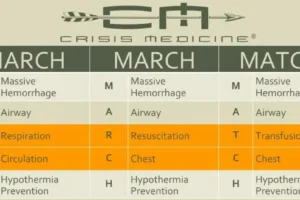
Industrial high-pressure water jet injury patterns: looks like a gunshot wound
- Posted by Mike Shertz MD/18D
- Categories (M) Massive Hemorrhage, MARCH
High-pressure water jet units deliver large volumes of water at very high pounds per square inch. Entry wounds can be small, but internal tissue damage extensive, similar to military rifles.
BLUF:
If the water jet is a bit further from the skin, penetration can be more of a blast pattern. Fatal massive hemorrhage with extremity injuries from artery and / or vein disruption has occurred. Penetrating torso injury with internal organ damage also occurs. Often, these high-pressure water jets are used in enclosed spaces, further complicating casualty evaluation, immediate hemorrhage control, and casualty extraction. Ultimately, TECC guidelines on the care of blast and penetrating trauma casualties while still in a high-risk environment seem well suited to guide the management of these casualties.
🕖 Reading Time, 4 minutes
High-pressure water jet units are capable of 10,000 to 40,000 psi. Small penetration wounds with extensive internal damage often characterize injuries associated with their use. Water volumes of up to 3.8 liters per second can result in a large pressure transfer into the wound.1 “Depending on the surface area of the nozzle, fluid velocity can mimic those of military rifles…”2 As the energy of the water jet dissipates, it causes a “blast pattern” of injury from the pressure wave rather than just direct penetration.2
In 2021, a fatal injury involving a high-pressure water jet unit occurred. Unfortunately, an adult male using the water unit was found dead at his construction site, having bled out of a femoral artery and vein complete transection in his left thigh.


In a review of twenty cases of injury by water jets1 through the year 2000:
- nine involved lower extremities,
- two involved neck wounds,
- one neck-injured casualty presented in profound shock with an over-one-inch laceration to their internal jugular and subclavian veins. This resulted in a substantial amount of bleeding around one lung
Lastly, there have been cases of inadvertent penetration into the abdomen resutling in a “large amount of blood” in the abdomen at surgery. From 1966 until 2014, there were ten published cases of similar penetrating abdominal injury. Accidents occurred secondary to hose blockage, five cases of misdirected spraying or a loose grip on the device, device malfunction, and one case of user error. 80% had damage to at least one intraabdominal organ.2 Bowel and colon perforations frequently occur.1

References:
1Tejero-Trujeque R. High-pressure water jet injuries: a surgical emergency. J Wound Care. 2000 Apr;9(4):175-9. doi: 10.12968/jowc.2000.9.4.25976. PMID: 11933301.
2Magneson F, O’Rear J. High pressure water jet injury to the abdomen: A case report and literature review. Occupational Med and Health Affairs. 2014.
3Ishigami A, Iwahashi Y, Ishida Y, Nosaka M, Kuninaka Y, Yamamoto H, Hashizume Y, Kondo T. Fatal injury by high-pressure water jet unit – A case report. J Forensic Leg Med. 2021 Nov;84:102270. doi: 10.1016/j.jflm.2021.102270. Epub 2021 Oct 28. PMID: 34742124.
4Radojevic N, Radnic B, Curovic I. Fatal Penetrating Injuries Sustained by High-pressure Water Jet Unit. J Forensic Sci. 2015 Nov;60(6):1652-3. doi: 10.1111/1556-4029.12861. Epub 2015 Aug 6. PMID: 26250721.
Dr. Mike Shertz is the Owner and Lead Instructor at Crisis Medicine. Dr. Shertz is a dual-boarded Emergency Medicine and EMS physician, having spent over 30 years gaining the experience and insight to create and provide his comprehensive, science-informed, training to better prepare everyday citizens, law enforcement, EMS, and the military to manage casualties and wounded in high-risk environments. Drawing on his prior experience as an Army Special Forces medic (18D), two decades as an armed, embedded tactical medic on a regional SWAT team, and as a Fire Service and EMS medical director.
Using a combination of current and historical events, Dr. Shertz’s lectures include relevant, illustrative photos, as well as hands-on demonstrations to demystify the how, why, when to use each emergency medical procedure you need to become a Force Multiplier for Good.



